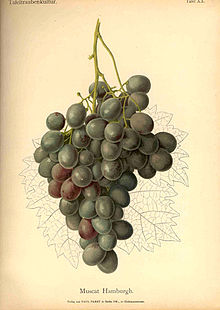Muscat Hamburg
| Black Muscat | |
|---|---|
| Grape (Vitis) | |

Rudolf Goethe: Handbuch der Tafeltraubenkultur
|
|
| Species | Vitis vinifera |
| Also called | Golden Hamburg, Muscat Hamburg, Black Hamburg (US); Muscat de Hambourg (France); Moscato di Amburgo (Italy); Muscat Gamburgskiy (Russia) |
| Origin | Germany |
| Notable regions | California, Virginia, Pacific Northwest, Vancouver Island, India, China, Eastern Europe |
Black Muscat (or Muscat of Hamburg) is a red Vitis vinifera grape variety derived from the crossing of the Schiava Grossa and Muscat of Alexandria. It is known under a variety of local names such as Golden Hamburg, and Black Hamburg in the US; Muscat de Hambourg (or Hamburgh) in France; Moscato di Amburgo in Italy; and Muscat Gamburgskiy in Russia and former Soviet Union countries. Confusingly, Black Hamburg is also used as a synonym for its maternal parent. It is commonly produced as table wine but in California's Central Valley it has been used in the production of dessert wine. As a dessert wine it can be highly aromatic with a rich coloring. In the US it is grown in wine appellations in California, Virginia, Oregon, Texas, and Washington. In Canada, it is also found on Vancouver Island.
In France, the grape is used chiefly as dessert grape including AOC varieties such as Muscat du Ventoux. In Eastern Europe, the grape produces a light, dry red wine. It is also starting to gain popularity as a table wine component in China.
Horticulturist Walter Clore has postulated that this grape might have been one of the first Vitis vinifera varieties planted in Washington State in the early 19th century.
During a series of trials between 1930 and 1935, Black Muscat was crossed with Raboso Piave to create the red Italian wine grape variety Manzoni Moscato.
...
Wikipedia
